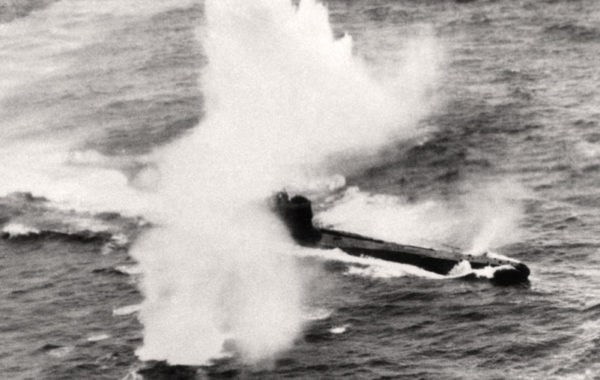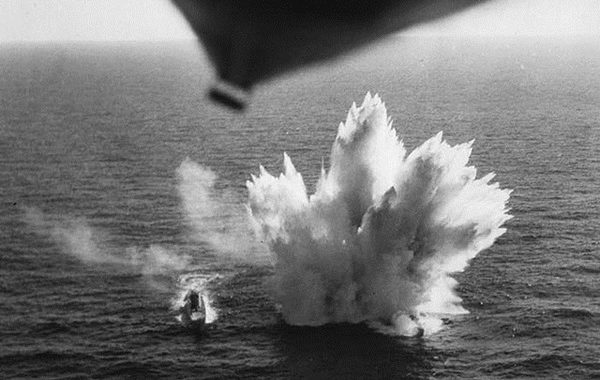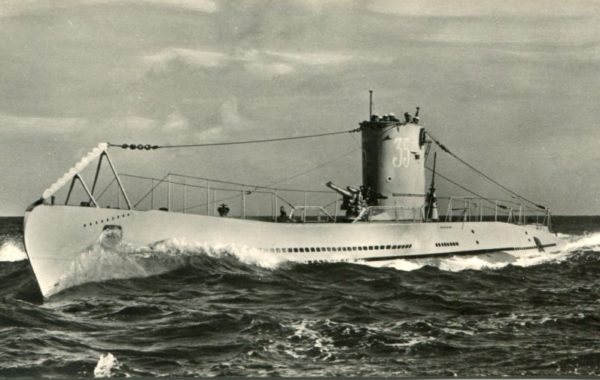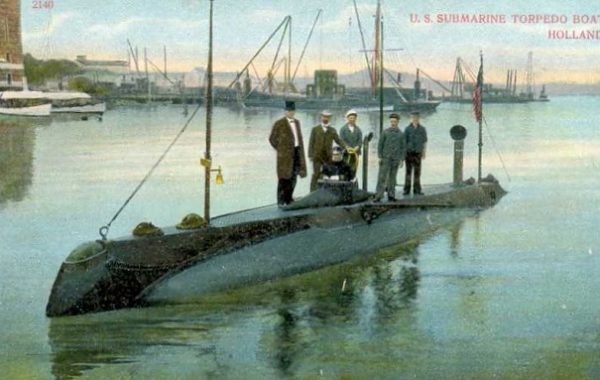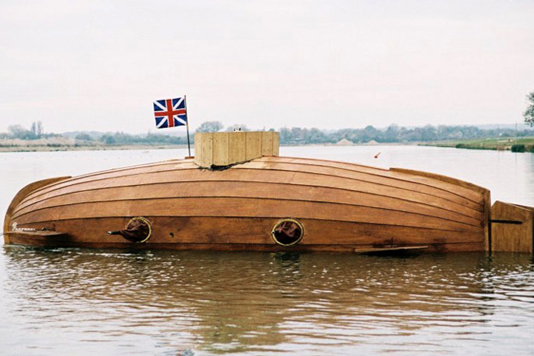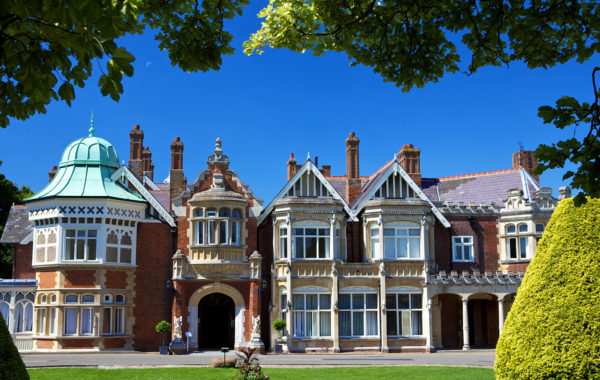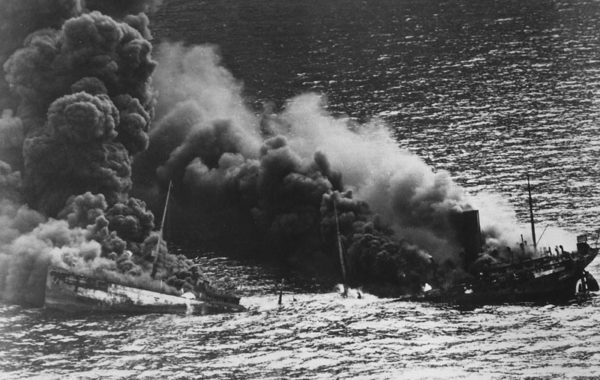When the United States entered World War II in December 1941, it did not take long for Hitler’s U-boats to bring the war to America’s shores. During the first eight months of 1942, U-boats sank more than 600 Allied ships off the East coast and in the Caribbean, before U.S. defenses stiffened. Partly as a consequence of this experience, when British Prime Minister Winston Churchill met with President Franklin Roosevelt in Casablanca in January, 1943, they agreed that war against the U-boats should be a top priority.
That same month, a change in command in Germany would mark the beginning of a long, slow decline in the Nazi submarine threat through the remainder of the war. Adolf Hitler promoted Karl Doenitz, the U-boat fleet commander, to Grand Admiral of the German Navy. Day-to-day command of the submarine fleet passed to Doenitz’s chief of staff, who lacked his boss’s strategic foresight and never gained the unquestioned loyalty of U-boat captains that Doenitz enjoyed.
Several developments began turning the tide of the naval war by mid-1943. The extended range of Allied aircraft meant that U-boats could no longer act with impunity in the mid-Atlantic. Airborne radar, which the Nazis did not think possible, gave Allied planes the opportunity to attack U-boats on the ocean’s surface at night. Improvements in high frequency direction-finding allowed the Allies to locate U-boats whenever they were in communications with their headquarters.
The Allied surface navies benefitted from advances in weaponry and improved tactics. The Hedgehog system fired depth charges in a circular pattern ahead of a suspected U-boat’s anticipated course. Certain charges detonated on contact, while others were time-fused so that even a near miss might explode and damage a U-boat enough to bring it to the surface.
New tactics created special convoy escort groups that began deploying in April of 1943. They consisted of up to ten anti-submarine warships operating in concert with an aircraft carrier and became known as “hunter-killer” groups. Once a U-boat was detected, using sonar, radio frequencies or aerial spotting, a number of the group’s warships would be dispatched to stay on top of the submarine until it had to come to the surface, where it was no match for the firepower of the ships that awaited it.
The hunters had become the hunted.
Following D-day and the invasion of France, the Allies lost 24 merchant ships from September through December of 1944. In that same period, Germany lost 55 U-boats.
From Sept. 3, 1939, to May 8, 1945, roughly 39,000 men took part in U-boat combat operations; 27,500 of those men never returned. U-boats accounted for about 2,700 merchant ships sunk during the war, more than one ship for every day of the war. But their success came at a high price: 87 percent of all U-boats that sailed on operational patrols were sunk or lost, and seven of every ten crew members died at sea.
War History
A Brief History of Submarines, Part 6
In the first few months of World War II, Germany’s U-boats were tasked with blockading British ports. In carrying out this assignment, U-boat fleet commander Karl Doenitz faced two challenges. The first was a limited number of submarines – only 21 ocean-going boats were available – and the second was their vulnerability to land-based British airpower.
To meet the first challenge, production of Type VII U-boats became a priority in the fall of 1939. The boats were small and took less time to build than larger surface ships. Within a year, German industry developed a system of prefabricating U-boat parts in different locations, which sped up production. Even so, it would take more than a year to begin supplying Doenitz with the number of Type-VII’s he wanted.
To meet the second challenge, Doenitz shifted U-boat operations to the mid-Atlantic, beyond the reach of land-based aircraft.
Working in this “killing zone,” U-boats sank 300,000 tons of allied shipping during the first four months of 1940. But this success came at a grim price: 13 U-boats sunk from January through April.
British convoys, escorted by warships, made merchant shipping difficult for U-boats to attack. The Royal Navy escorts employed radar and an underwater sonic detection system known as ASDIC, to locate German submarines. The more audacious U-boat captains responded by attacking at night, surfacing their boats inside convoy formations. ASDIC could not locate a boat on the surface, and attacking from within the convoy neutralized radar detection because a U-boat was largely indistinguishable on radar screens from the ships it was attacking.
When France fell to Germany in the summer of 1940, Doenitz gained access to ports on the Bay of Biscay. This allowed his U-boats to reach the mid-Atlantic more quickly and stay on station for longer periods.
Up until this point in the war, U-boats had been operating largely on their own. Each boat patrolled a specific area, attacking merchant ships and convoys when they were detected in its combat zone. But this approach was about to change in a way that would dramatically alter the course of the war.
More in our next blog.
A Brief History of Submarines, Part 5
In 1938, German Chancellor Adolf Hitler approved a grand blueprint for building a German navy capable of challenging Great Britain’s dominance of the high seas. The ambitious “Plan Z” was due to be completed in 1948, but it had to be abandoned when Hitler invaded Poland on Sept. 1, 1939.
The German U-boat fleet commander, Karl Doenitz, had hoped to have some 300 attack submarines before going to war with the British. Instead, he had a fleet of 65 boats, only 21 of which were ocean-going attack U-boats. The design of these boats had been distilled from World War I submarines and reworked in secret by German engineers in the Netherlands.
The result was an agile, 600-ton U-boat, known as the Type VII. Its twin diesel engines could push the boat to a maximum speed of 17 knots while on the surface, but when the boat was submerged, its two battery-powered electric motors could make only half that speed. The boat was armed with four torpedo tubes in the bow and one in the stern. Including reloads, these initial U-boats carried 11 torpedoes. An 88-millimeter (mm) cannon was mounted on the deck in front of the boat’s conning tower, and a 20mm anti-aircraft gun was typically located on the deck behind the tower or, later, on the rear of the conning tower bridge itself. The submarine had become a formidable weapon of war.
The initial design, a Type VIIA, could operate underwater for about 48 hours before having to surface to recharge the batteries and provide welcome fresh air for the 40-man crew. As a result, U-boats, despite their name, spent most of their time on the ocean’s surface. By the end of the war Germany would build more than 1,100 U-boats, 709 of which were Type VII variants.
When England declared war on Germany, Sept. 3, 1939, Doenitz had already dispatched 19 U-boats in his ocean-going fleet to stations north and south of the sea lanes into the British Isles. The primary target for Germany’s navy was merchant shipping, as the Nazis sought to deny the raw materials and food supplies so vital to the British economy. U-boats sank several merchant ships, including a passenger liner, during the first days of the war. The damage prompted the British Admiralty to quickly adopt the convoy system it had employed in the previous war.
In the lead-up to World War II, Germany had focused most of its naval resources on “capital ships,” the battleships and heavy cruisers by which modern navies measured their prestige. Within a year, however, most of Germany’s capital ships had been neutralized by the larger British Royal Navy. This left the U-boat as the Nazi’s principal naval weapon, and it would prove more than equal to the task, as we will see in our next blog.
A Brief History of Submarines, Part 2
As the 19th century drew to a close, submarine design innovation began to accelerate. Irish inventor John Phillip Holland, working in America, resolved the thorny problem of propulsion by combining an internal combustion engine for surface travel with electric battery power for submerged operation. The “Holland Type VI,” his most successful model, became the U.S. Navy’s first commissioned submarine in 1900.
In the first decade of the new century diesel engines became the preferred source of surface propulsion, reducing the fire danger posed by gasoline or kerosene engines. More powerful battery-driven electric motors provided greater range underwater. A further innovation allowed batteries to be recharged by a submarine’s main engines while running on the surface. During this period, France introduced the now-classic double-hull design (a pressure hull inside an outer hull).
On the eve of World War I, the Royal Navy fleet included 74 submarines, 15 of which were oceangoing boats with a range of 2,500 miles and cruising speed of ten knots. These were the first submarines equipped with a deck gun forward of the conning tower, producing a silhouette recognizable as the first modern submarine.
Yet, with all these innovations and developments, the submarine’s full potential as a weapon of war was not apparent to Europe’s naval commanders. Battle strategies anticipated squadrons of surface vessels, led by massive battleships (dreadnaughts) throwing shells 20 miles or more, slugging it out for control of the high seas. By contrast, the submarine was seen as best suited for coastal protection and attacking blockades.
But World War I would lead to changes in naval strategy and tactics that would favor the submarine’s unique characteristics. More about that in our next blog.
A Brief History of Submarines, Part 1
From the earliest days of sail, ancient civilizations dreamed of a vessel that could carry sailors underwater to unlock the ocean’s mysteries and, not surprisingly, to attack enemy ships by surprise. Over centuries many ideas were committed to paper, but none proved practical when brought to life.
The first successful submarine was developed by a Dutch inventor, Cornelius Drebbel, working for the King of England. Drebbel tested his wooden ship in the early 17th century on the River Thames. Powered by oars, the craft could submerge and surface at will and could remain underwater for up to three hours with the help of snorkel-like tubes. While Drebbel’s design validated the concept of the submarine, the world would wait another 250 years for advances in science and technology to begin to unlock its full potential.
A German-American engineer built the first modern submarine in 1866 for the Pacific Pearl Co. The “Sub Marine Explorer” could reach a depth of 100 feet, used compressed air to equalize pressure on the hull, and maneuvered underwater with a hand-powered propeller. Unfamiliarity with “decompression sickness” (known today as “the bends”) and overfishing the pearl beds off Panama’s coast led to the craft being abandoned three years later.
Across the Atlantic, the same year the Sub Marine Explorer made its maiden voyage, the first modern, self-propelled torpedo was designed in England. Powered by compressed air, the torpedo could travel eight miles per hour and reliably strike a target at 700 yards, potentially making the submarine a more viable weapon of war.
Submarines and torpedoes came together in the 1880’s. Incorporating design advances from French and Spanish engineers, the Nordenfelt IV, built by a Swedish industrialist, was armed with two torpedoes. The 100-ton, twin screw vessel was powered by steam on the surface and propelled underwater by pressure built up when the engine ran on the surface. Nevertheless, technical problems remained – chief among them was need for a source of long-distance underwater propulsion.
The most promising answer to the propulsion question appeared to be electric motors. In 1884 a Polish-Russian engineer successfully tested a battery-driven one-horsepower motor in a submerged boat in the Neva River. But the limitations of early batteries restricted the submarine’s range underwater and failed to attract the support of naval officials in Europe and the Americas. Yet each subsequent design added new innovations (i.e. periscope, hydroplanes, electric gyroscope) that would prove indispensable with the development of the modern submarine at the dawn of the 20th century.
In my next blog, the submarine becomes a devastating new weapon of war.
British Codebreaking and the Bletchley Park Connection
As the German Army began invading Poland on Sept. 1, 1939, the Polish codebreakers prepared to vacate Warsaw. They were careful to take with them or destroy all evidence of their years of success in reading German military messages sent by the Enigma cypher device (see my blog, “The Evolution of Enigma,” May 16, 2018).
Two weeks later the Poles entered Rumania, took a train to Bucharest and contacted the French Embassy. By the beginning of October, they were safe in a French chateau about 25 miles northeast of Paris, along with two replica Enigma machines they had smuggled out of Poland. By now, however, the principal effort to decode Enigma was shifting across the English Channel to a country manor in Buckinghamshire, 50 miles northwest of London.
Bletchley Park, an ornate stone edifice set on 58 acres of private land, had become the new home of the British Government Code & Cypher School (GC&CS). Bletchley was considered a much safer wartime location than the school’s previous home in London.
The estate sat almost equidistant on the rail line between Oxford and Cambridge, the universities whose faculty members and top students would supply much of Britain’s codebreaking brainpower. To ramp up its efforts, the GC&CS had begun recruiting linguists, chess champions, cryptic crossword puzzlers, and mathematicians; people with skills uniquely suited to cryptanalysis.
Early efforts to read the German signals were fruitless, owing to the changes in coding procedures introduced prior to Germany’s Polish invasion. In early 1940, one of Britain’s top codebreakers, mathematician Alan Turing, visited his Polish cohorts in France and gained several key insights, including the wiring scheme for the German military Enigma. Within months of his return to Bletchley, Turing devised his initial electromechanical computing machine, which he called a “bombe.” His device helped defeat some of the new German cyphering practices..
By transmitting only once, instead of twice, the three-letter setting used to encode an Enigma message (see March 16 blog), the Germans had made it much more difficult for British codebreakers to work out the correct setting in a timely manner. Touring’s machine, however, sped up the process by quickly eliminating most of the unlikely three-letter sets.
By mid-1940 Bletchley cryptanalysts were reading the German Army and Air Force signals within days, or even hours, of receiving the coded messages. It helped that both services continued to use the same five wheels they had been using for years to make up the three-wheel combinations for their Enigma transmissions. The internal wiring of these five wheels had long-since been worked out by the Poles.
But the Naval Enigma signals remained a mystery. Instead of five wheels from which to choose, the Navy added three more individual wheels, greatly complicating Britain’s codebreaking efforts. Even more complicated was the way in which the Navy identified the three-letter settings (called “trigrams”) for encoding messages,
The process used a pre-determined list of three-letter indicators. The message sender chose one of these trigrams to encode the message and a second “dummy” trigram. The two trigrams, plus two random letters, were used to construct four two-letter “bigrams.” The sender then consulted a bigram table that showed a conversion for every possible bigram into a second, unrelated bigram. These eight letters were then sent by Morse code at the beginning of the message along with the enciphered message.
By the end of 1939, Turing believed he understood how this system worked to identify the trigram for each encoded naval message. But understanding the system did not allow him to read Navy Enigma signals without a copy of the bigram table.
By the summer of 1940, an enhanced version of Turing’s bombe was being built. If they had enough plain-text German Naval messages along with their encryptions (what cryptanalysts termed a “crib”), the “super bombe” could break the Naval Enigma. But it was a classic conundrum: without cribs they could not break Enigma messages, yet without breaking Enigma messages they could not obtain cribs.
There was, however, one other possibility, as we will see in our next blog.
World War II on Our Doorstep
Following the attack on Pearl Harbor in December, 1941, Americans feared Japanese assaults on the west coast of the United States. Indeed Japanese submarines shelled targets in California and Oregon, and Japanese soldiers invaded the Aleutian Islands in Alaska for a brief time in 1942. But many Americans might be surprised to learn that during the first half of 1942, far more damage was caused by German submarines in waters off the East and Gulf coasts.
When Germany declared war on the U.S. four days after Pearl Harbor, Hitler sent a small fleet of U-boats to the East Coast. They quickly began sinking American cargo ships, many within sight of some of the nation’s largest cities. From February through May, 1942, U-boats sank 348 ships and killed an estimated 5,000 merchant seamen.
U-boat crews were surprised that the American freighters were not traveling in convoys and that cities and towns along the eastern seaboard were not blacked out. As a result, U.S. vessels were silhouetted at night by the bright city lights that made them easy targets.
In spite of the carnage taking place in U.S. waters, the Navy appeared reluctant to establish a formal system of convoys along the east coast. One reason for this was a shortage of warships. The limited number of U.S. destroyers were already helping protect convoys in the North Atlantic and fighting the Japanese in the Pacific. The U.S. Maritime Service called for coastal cities to adopt blackout conditions at night, but city fathers were reluctant to do so because blackouts were seen as bad for business.
In May, 1942, coastal centers agreed to a “dim-out” of their lights, but this was only partially effective, due to arguments over what constituted “essential lighting” for a city or town. It wasn’t until July 7 that the U.S. Government ordered blackouts for coastal cities. After that the U-boats moved on to more prolific hunting grounds in the Caribbean and Gulf of Mexico.
By effectively targeting tankers carrying oil from Texas and Louisiana ports, U-boats sank nearly a third of the existing U.S. tanker fleet. Their success not only threatened to cut off vital supplies bound for the British Isles, but also supplies of heating oil for eastern cities. The U.S. Navy was finally galvanized into action.
Using Coast Guard ships and armed trawlers on loan from the British Admiralty, Navy officials organized a “bucket brigade” convoy system. The convoys put in at ports along the Gulf and East coasts during nighttime, the period when U-boats did their greatest damage. Sinkings dropped dramatically in 1943, and most U-boats were reassigned to the North Atlantic.
U.S. industrial might slowly began to assert itself. Airplanes, warships and cargo ships began rolling off assembly lines as America’s military might steadily grew. But few in the U.S. Maritime Service would ever forget the six months when German U-boats had been the undisputed masters of American waters.
Rhoda’s Story: Part 4 The SS Athenia is Torpedoed…
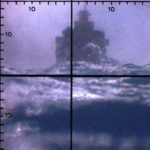
Photo credit: wreckhunter.net
In Part 3 of Rhoda’s Story, my grandmother boarded Athenia in Liverpool, England, on Sept. 2, 1939. The next day, Sept. 3, word reached the ship that Britain had declared war on Germany. While Rhoda was concerned about the danger posed by German submarines, she and many other passengers believed they would be out of danger before anything might happen.
Her story continues:
Just before the evening meal, I went down to my cabin, washed, and changed my dress for dinner. I took my coat and hat with me as I decided to come back up on deck right after. Mrs. Townley said she didn’t feel well, but she ate dinner and we both went up on deck and found a seat [on the] starboard side of the hatchway. About fifteen or twenty minutes past seven, as we sat there, a terrific explosion suddenly occurred. Something struck the port side of the ship, and she seemed to keel over on her side and the water came over the deck. The lights went out all over the inside of the ship and a dense cloud of gas-filled smoke seemed everywhere. I was thrown down and as I picked myself up and turned around, I saw out on the water about a half a mile away, a long-shaped dark object with black smoke around it, and in a flash I knew what had happened.
The panic, the screaming and cries of the women and children [were] terrible. …The officers and men were shouting and hurrying to get the lifeboats lowered. I just stood there, knowing the ship was doomed and thinking of my home and family and wondering if I should ever see them again, and yet I didn’t seem to be afraid and felt quite calm. I turned to a panic-stricken woman, put my arms around her and said, “Don’t be afraid, God will save us; let us put our faith in him.”
She said, “If there is a God, why did He let this happen?”
I said, “This is the devil’s work, and God is mightier than the devil. He’ll save us,” and I led her to the side of the ship, and saw her get into a lifeboat.
I cannot describe all the scenes around me just then. It seemed such a scramble and so much shouting and screaming, especially when we heard another shell fired which seemed to burst overhead. I only remember climbing over the side of the ship and down a rope ladder, [then to] drop off the ladder into the lifeboat. I also remember hearing a boy cry, “There’s my mother on the ladder. Oh, please wait for my mother.” But they said the boat was overloaded and pulled away. I turned around to see a gray-haired woman clinging to the ladder, and her two children, a boy, 15, and a little girl, nine, pulling way in our lifeboat. They both cried for their mother all night long.
After we got clear of the Athenia, it became very dark and began to rain, and we found water coming in the boat. …We found a pail in the boat and started to bail out the water. …I was glad I had a warm coat on, as there were those in the boat that only had a thin dress on and some only night clothes, and it was very cold. I took the bottom part of my coat and wrapped it around a poor shivering woman who stood by me crying, with just a thin dress on… [I] tried to comfort her by repeating the 23rd Psalm. By that time, I was standing ankle deep in oil and water. Then someone asked me to please take a baby under my coat to keep it warm, as it had only a little shirt on. I took the baby; I judged it to be about eighteen months old. The baby was asleep.
The sea was heavy and at times I thought we would capsize. …I got very tired. [T]he baby lay a dead weight in my arms, and as I was standing, every time the boat lurched, I had difficulty keeping my balance, then one of the boys [who was] rowing called for someone else with a coat to take the baby and give me a rest. Finally a girl sitting on the other side of the boat took [the infant] from me.
In my next blog, Rhoda witnesses a tragedy.
Need to catch up on the story? Please visit www.thomascsanger.com
Rhoda’s Story, Part 1: Joy of Reunion — Then ‘A Thunderbolt’
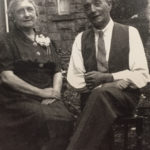
Rhoda with her brother, Albert Fisher, in Street, Somerset, August 1939.
Photo credit: Family picture
My grandmother, Rhoda Thomas, was a passenger aboard the British liner Athenia when the ship was torpedoed by a German submarine Sept. 3, 1939, at the start of World War II. She survived the attack, was rescued, and returned home to her family in Rochester, NY, where she later wrote an account of these events she titled “Experiences of an Athenia Survivor.” My next several blogs will be devoted to Rhoda’s story, in her own words.
July 29, 1939, I sailed on the new Mauretania from New York. It was with some misgivings that I said goodbye to home and family, especially my husband. As the ship sailed out of New York, something seemed to rise up and choke me and I wished I had never made up my mind to go. I felt like walking off the ship and returning home. Perhaps it was a foreboding of the terrible happenings that were to follow. However, it passed, and I soon found myself getting acquainted with my cabin mates and other passengers, and telling myself how foolish I had been to allow such a state of mind to possess me.
Rhoda arrived in England August 5th and was met by her brother and niece. They drove back to Street, the town in southwestern England where she had been born and raised. There she spent nearly three weeks gathering with relatives and old friends, enjoying shopping, teas, days at the seaside, and driving trips to the country.
The time passed all too quickly. Our conversation and talks at time would center on topics concerning the possibility of war, and very few were of the opinion that there would be war. They had passed through such a crisis a year ago, worse than this and were sure a peaceful settlement could be reached. Therefore, they refused to worry over Hitler’s claim to Danzig and the Polish Corridor. England was negotiating with Russia and all in all they were sure Hitler would be afraid to start anything against such a powerful opposition. Then August 24, just like a thunderbolt, the news came that Germany had signed a non-aggression pact with Russia.
It was like a stab in the back for the English people. They seemed stunned, speechless, not knowing whether to blame their government or lay it to the treachery of Hitler and his aids. But one thing was certain: that was war was inevitable.
In my next blog, advice from the U.S. Embassy sends Rhoda scrambling for passage back to America.
Contact Tom for speaking engagements: tomsanger@msn.com
Without Warning on Amazon: http://bit.ly/WithoutWarningonAmazon
Athenia Found?
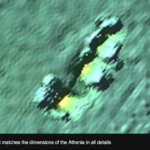
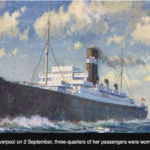

After decades of obscurity, British science correspondent, Jonathan Amos, earlier this month published a story on the BBC’s website about the possible identification of Athenia‘s wreck on the sea floor of the Rockall Bank. The wreck is very near the location given repeatedly by Athenia‘s radio officer, David Don, after the ship was torpedoed Sept. 3, 1939.
Follow this link to read the BBC story:
http://www.bbc.com/news/science-environment-41503664
www.ThomasCSanger.com
Tom speaks about why he wrote his historical novel “Without Warning:”
“I first became interested in writing about Athenia, a British passenger liner sunk by a German U-boat, because my grandmother, Rhoda Thomas, was aboard the ship. Over the years, I found that many people knew of the Lusitania, which was torpedoed by a U-boat during World War I, but few had ever heard of Athenia, even though 30 Americans died in that attack, more than two years before Pearl Harbor. In researching the book, I read many inspiring and harrowing accounts written by other survivors and spoke to a handful of them who are still alive. What began as a project to remember my grandmother has become for me an effort to honor the memories of Athenia’s passengers whose heroism and sacrifices have been overshadowed by the war’s greater conflagrations.”


